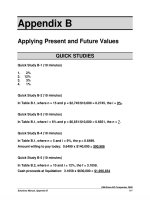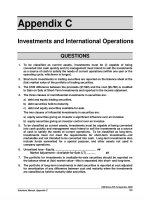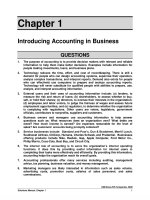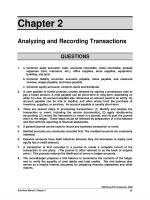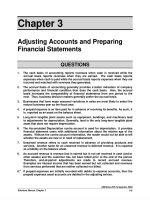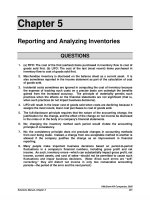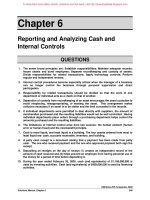Solution manual financial accounting 4e by wild 04 chapter
Bạn đang xem bản rút gọn của tài liệu. Xem và tải ngay bản đầy đủ của tài liệu tại đây (479.59 KB, 65 trang )
To download more slides, ebook, solutions and test bank, visit
Chapter 4
Reporting and Analyzing
Merchandising Operations
QUESTIONS
1.
Additional accounts of a merchandising company likely include Merchandise
Inventory, Sales (of goods), Cost of Goods Sold, Sales Discounts, and Sales Returns
and Allowances (and possibly Delivery Expense).
2.
Merchandising companies report Merchandise Inventory on the balance sheet,
service companies do not. Also, merchandising companies report both Sales (of
goods) and Cost of Goods Sold on the income statement, while service companies
do not.
3.
A company can have a net loss if its expenses (absent cost of goods sold) are
greater than its gross profit from sales of merchandise.
4.
A cash discount can be offered to encourage customers to promptly pay. This
provides cash more quickly to the seller and avoids the costs of additional
collection activities—of course, the seller must perform a costs vs. benefits analysis
on the merits and terms of any cash discount offered to customers.
5.
For a perpetual inventory system, inventory shrinkage is determined by taking a
physical count of the inventory available at the end of a period and comparing that
amount with the amount recorded in the Merchandise Inventory account.
6.
Cash discounts are granted in return for early payment and reduce the amount paid
below the negotiated price. Cash discounts are recorded in the accounting records
(as a reduction of Merchandise Inventory). Trade discounts are deducted from the
list or catalog price to determine the purchase (negotiated) price. Trade discounts
are not recorded in the accounting records.
7.
Sales discount is a term used by a seller to describe a cash discount granted to a
customer. Purchase discount is a term used by a purchaser to describe a cash
discount received from a seller. (It is a matter of perspective: seller versus buyer.)
8.
A manager is concerned about the quantity of its purchase returns because the
company incurs costs in receiving, inspecting, identifying, and returning the
merchandise. More returns create more expenses. By knowing more about returns,
the manager can decide if they are a problem and how they can be minimized.
9.
The sender (maker) of a debit memorandum records a debit in an account of the
recipient; and the recipient records a credit in an account maintained for the sender.
©McGraw-Hill Companies, 2008
Solutions Manual, Chapter 4
225
To download more slides, ebook, solutions and test bank, visit
10. The single-step income statement format presents cost of goods sold and expenses
in one list, totals the list, and subtracts the total from net sales in one step. The
multiple-step format presents intermediate totals, including gross profit (the
difference between net sales and cost of goods sold) and sub-categories of
expenses (often by key activities).
11. Best Buy calls its inventory account ―Merchandise Inventories.‖
calculation of cost of goods sold is not presented for Best Buy.
A detailed
12. Circuit City calls its cost of goods sold account ―Cost of sales, buying, and
warehousing.‖
13. Apple reports a separate gross margin figure on its consolidated statement of
income. Its 2004 gross profit is $2,259,000,000.
14. A buyer should attempt to negotiate the shipping terms FOB destination. In this
case, title will pass after the goods are safely delivered to the buyer’s business and
transportation charges will be the responsibility of the supplier (seller).
QUICK STUDIES
Quick Study 4-1 (10 minutes)
Mar. 5 Merchandise Inventory .........................................
Accounts Payable .........................................
4,800
4,800
To record credit purchase [(600 x $10) x 80%].
Mar. 7 Accounts Payable .................................................
Merchandise Inventory ................................
200
200
Returned defective units [(25/600) x $4,800].
Mar. 15 Accounts Payable ................................................
Cash ...............................................................
Merchandise Inventory* ...............................
4,600
4,508
92
Paid for purchase less cash discount
*[(4,800 - $200) x 2%].
©McGraw-Hill Companies, 2008
226
Financial Accounting, 4th Edition
To download more slides, ebook, solutions and test bank, visit
Quick Study 4-2 (10 minutes)
Apr. 1 Accounts Receivable ............................................
Sales ..............................................................
3,000
3,000
To record credit sale.
1 Cost of Goods Sold ...............................................
Merchandise Inventory ................................
1,800
1,800
To record cost of credit sale.
4 Sales Returns and Allowances ............................
Accounts Receivable ...................................
600
600
To record sales return.
4 Merchandise Inventory .........................................
Cost of Goods Sold ......................................
360
360
Restore cost of returned goods to inventory.
11 Cash ........................................................................
Sales Discounts* ...................................................
Accounts Receivable ....................................
2,352
48
2,400
Received payment less cash discount
*[($3,000 - $600) x 2%].
Quick Study 4-3 (10 minutes)
(a)
Sales ............................................$150,000
Sales discounts .......................... (5,200)
Sales returns and allowances ....... (20,000)
Net sales ...................................... 124,800
Cost of goods sold ..................... (79,600)
Gross profit .................................$ 45,200
Gross margin ratio:
(Gross profit / Net sales) ........
36.2%
(b)
$550,000
(17,500)
(6,000)
526,500
(329,700)
$196,800
37.4%
(c)
(d)
$38,700 $255,700
(600)
(4,200)
(5,300)
(900)
32,800
250,600
(24,300) (126,900)
$ 8,500 $123,700
25.9%
49.4%
Interpretation of gross margin ratio for case a: The ratio of 36.2% implies
that for each dollar in net sales the company earns 36.2 cents in gross
profit. The company must still deduct other expenses that it incurs in
running the business when computing net income.
©McGraw-Hill Companies, 2008
Solutions Manual, Chapter 4
227
To download more slides, ebook, solutions and test bank, visit
Quick Study 4-4 (10 minutes)
July 31 Cost of Goods Sold .............................................
Merchandise Inventory ..............................
1,900
1,900
To adjust for shrinkage based on
physical count [$37,800 - $35,900].
Quick Study 4-5 (10 minutes)
July 31 Sales .......................................................................
Income Summary ..........................................
160,200
160,200
To close temporary accounts with credit balances.
July 31 Income Summary ..................................................
Sales Discounts ...........................................
Sales Returns and Allowances ...................
Cost of Goods Sold* .....................................
Depreciation Expense ..................................
Salaries Expense ..........................................
Miscellaneous Expenses ..............................
165,900
4,700
6,500
106,900
10,300
32,500
5,000
To close temporary accounts with debit
balances. (*$105,000 + $1,900 —from QS 4-4)
Quick Study 4-6 (10 minutes)
Acid-test ratio = ($1,500 + $2,800) / ($5,750 + $850) = 0.65
Explanation of acid-test ratio: The acid-test ratio is used to evaluate (reflect on)
the liquidity of a company. It helps in determining whether a company will be
able to meet its current obligations as they come due with its most liquid assets.
In this case, the company only has 65 cents available in quick assets to pay $1.00
in current liabilities as they come due. An acid-test ratio less than one usually
suggests some concern and encourages further analysis of liquidity.
Quick Study 4-7 (10 minutes)
Similarities: Both the acid-test ratio and current ratio are used to assess liquidity.
Both ratios are computed with current liabilities as the denominator.
Differences: The current ratio includes current assets in the numerator. The acidtest ratio includes current assets less inventories and prepaids in its numerator
(leaving cash & equivalents, current receivables, and short-term investments).
Comparison and Description: Compared with the current ratio, the acid-test ratio
is a more stringent test of a company’s ability to meet its current obligations. The
acid-test ratio is more stringent as it does not assume a company relies on
prepaids and inventory to pay current liabilities. This is because prepaids and
inventory assets are not generally available to satisfy current obligations.
©McGraw-Hill Companies, 2008
228
Financial Accounting, 4th Edition
To download more slides, ebook, solutions and test bank, visit
Quick Study 4-8A (5 minutes)
a.
b.
c.
d.
e.
Perpetual inventory system
Perpetual inventory system
Periodic inventory system
Perpetual inventory system
Perpetual inventory system
Quick Study 4-9A (10 minutes)
Mar. 5 Purchases ...............................................................
Accounts Payable ..........................................
4,800
4,800
To record credit purchase [(600 x $10) x 80%].
7 Accounts Payable ..................................................
Purchases Returns & Allowances ...............
200
200
Returned defective units [(25/600) x $4,800].
15 Accounts Payable ..................................................
Cash ................................................................
Purchases Discounts*...................................
4,600
4,508
92
Paid for purchase less cash discount
* [($4,800 - $200) x 2%)].
Quick Study 4-10A (10 minutes)
Apr. 1 Accounts Receivable ............................................
Sales ..............................................................
3,000
3,000
To record credit sale.
4 Sales Returns and Allowances ............................
Accounts Receivable ...................................
600
600
To record sales return.
11 Cash ........................................................................
Sales Discounts* ...................................................
Accounts Receivable ....................................
2,352
48
2,400
Received payment less cash discount
*($3,000 - $600) x 2%.
©McGraw-Hill Companies, 2008
Solutions Manual, Chapter 4
229
To download more slides, ebook, solutions and test bank, visit
EXERCISES
Exercise 4-1 (30 minutes)
Apr. 2 Merchandise Inventory ..........................................
Accounts Payable—Lyon ...............................
4,600
4,600
Purchased merchandise on credit.
3 Merchandise Inventory ..........................................
Cash .................................................................
300
300
Paid shipping charges on purchased
merchandise.
4 Accounts Payable—Lyon ......................................
Merchandise Inventory ...................................
600
600
Returned unacceptable merchandise.
17 Accounts Payable—Lyon ......................................
Merchandise Inventory* .................................
Cash .................................................................
4,000
80
3,920
*[($4,600 - $600) x 2%]
Paid balance (less 2%) within discount period.
18 Merchandise Inventory .........................................
Accounts Payable—Frist ...............................
8,500
8,500
Purchased merchandise on credit.
21 Accounts Payable—Frist .......................................
Merchandise Inventory ..................................
1,100
1,100
Received an allowance on purchase.
28 Accounts Payable—Frist .......................................
Merchandise Inventory* .................................
Cash .................................................................
7,400
148
7,252
*[($8,500 - $1,100) x 2%]
Paid balance (less 2%) within discount period.
©McGraw-Hill Companies, 2008
230
Financial Accounting, 4th Edition
To download more slides, ebook, solutions and test bank, visit
Exercise 4-2 (30 minutes)
1.
BUYER- Santa Fe Company
Credit Purchase
Merchandise Inventory ........................................
Accounts Payable .........................................
24,000
24,000
Purchased merchandise on credit.
Cash Payment
Accounts Payable ................................................
Merchandise Inventory* ...............................
Cash ...............................................................
24,000
720
23,280
*[24,000 x 3%]
Paid account payable within 3% discount period.
2.
SELLER – Mesa Company
Credit Sale
Accounts Receivable ...........................................
Sales...............................................................
24,000
24,000
Sold merchandise on account.
Cost of Goods Sold .............................................
Merchandise Inventory ................................
16,000
16,000
To record cost of sale.
Cash Collection
Cash .......................................................................
Sales Discounts ....................................................
Accounts Receivable ....................................
23,280
720
24,000
Collected account receivable.
3.
Amount borrowed to pay with discount ...............................
Annual rate of interest ...........................................................
Interest per year ......................................................................
$ 23,280
x 8%
$1,862.40
Interest per day ($1,862.40 / 365 days) ..................................
$
Savings from discount taken ($24,000 - $23,280) ................
Interest paid on 50-day loan (50 days x $5.10) .....................
Net savings from borrowing to pay in discount period ..........
$ 720.00
(255.00)
$ 465.00
5.10
©McGraw-Hill Companies, 2008
Solutions Manual, Chapter 4
231
To download more slides, ebook, solutions and test bank, visit
Exercise 4-3 (10 minutes)
1.
2.
3.
4.
5.
J
A
B
F
E
6.
7.
8.
9.
10.
D
G
H
I
C
Exercise 4-4 (30 minutes)
May 5
Accounts Receivable ...........................................
Sales ...............................................................
21,000
21,000
Sold merchandise on credit (1,500 x $14).
5
Cost of Goods Sold ..............................................
Merchandise Inventory .................................
15,000
15,000
To record cost of sale (1,500 x $10).
a.
May 7
Sales Returns and Allowances ...........................
Accounts Receivable ....................................
2,800
2,800
Accepted a return from a customer (200 x $14).
7
Merchandise Inventory ........................................
Cost of Goods Sold ......................................
2,000
2,000
Returned merchandise to inventory (200 x $10).
b.
May 8
Sales Returns and Allowances ............................
Accounts Receivable .....................................
600
600
Granted allowance for damaged merchandise.
c.
May 15 Sales Returns and Allowances ............................
Accounts Receivable .....................................
680
680
Granted allowance for mis-colored merchandise
and accepted a return from a customer for the
mis-colored merchandise [$120 + (40 x $14)].
15 Merchandise Inventory .........................................
Cost of Goods Sold .......................................
400
400
Returned merchandise to inventory (40 x $10).
©McGraw-Hill Companies, 2008
232
Financial Accounting, 4th Edition
To download more slides, ebook, solutions and test bank, visit
Exercise 4-5 (15 minutes)
May 5
Merchandise Inventory .........................................
Accounts Payable ..........................................
21,000
21,000
Purchased merchandise on credit (1,500 x $14).
a.
May 7
Accounts Payable .................................................
Merchandise Inventory ..................................
2,800
2,800
Returned unwanted merchandise (200 x $14).
b.
May 8
Accounts Payable .................................................
Merchandise Inventory ..................................
600
600
To record allowance for damaged merchandise.
c.
May 15 Accounts Payable .................................................
Merchandise Inventory ..................................
680
680
To record allowance for mis-colored goods and
return of mis-colored merchandise
$120 + (40 x $14).
Exercise 4-6 (25 minutes)
1. Entries for Sydney Company (BUYER):
May 11 Merchandise Inventory ........................................
Accounts Payable ..........................................
40,000
40,000
Purchased merchandise on credit.
11 Merchandise Inventory ........................................
Cash ................................................................
345
345
Paid shipping charges on purchased
merchandise.
12 Accounts Payable .................................................
Merchandise Inventory .................................
1,400
1,400
Returned unacceptable merchandise.
20 Accounts Payable .................................................
Merchandise Inventory* ................................
Cash ................................................................
38,600
1,158
37,442
Paid balance within the 3% discount period.
*($38,600 x .03).
©McGraw-Hill Companies, 2008
Solutions Manual, Chapter 4
233
To download more slides, ebook, solutions and test bank, visit
Exercise 4-6 — continued
2. Entries for Troy Corporation (SELLER):
May 11 Accounts Receivable ...........................................
Sales...............................................................
40,000
40,000
Sold merchandise on account.
11 Cost of Goods Sold ..............................................
Merchandise Inventory .................................
30,000
30,000
To record cost of sale.
13 Sales Returns and Allowances ...........................
Accounts Receivable ....................................
1,400
1,400
Accepted a return from a customer.
13 Merchandise Inventory .......................................
Cost of Goods Sold ......................................
800
800
Returned goods to inventory.
21 Cash .......................................................................
Sales Discounts ....................................................
Accounts Receivable ....................................
37,442
1,158
38,600
Collected account receivable.
Exercise 4-7 (20 minutes)
In today’s competitive world, organizations must concentrate on meeting their
customers’ needs and avoiding dissatisfaction. If these needs are not met and
dissatisfaction grows, the customers will deal with other companies or entities.
One measure of dissatisfaction of customers is the amount of sold goods that are
later returned. Customer dissatisfaction needs to be understood and then dealt
with promptly to encourage them to remain loyal. The reasons for the return also
need to be determined to allow the problem to be avoided in the future. For
example, the returns might arise from product defects, shipping damage,
misleading information provided at the time of sale, or fickle customers.
An important early step in controlling returns is to have information about their
dollar amount. In addition, managers can set goals for reducing the dollar
amount of sales returns. Both objectives can be helped by having the company’s
accounting system record the sales value of returned goods in a separate contra
account instead of the Sales account. This approach captures the information at
the time of the return and allows it to be easily reported.
While a company’s sales return record is important for managers, it is also
valuable information for external decision makers. This information can help
external users identify organizations focusing on customer satisfaction and
product quality. Although management might choose to report the amount of
sales returns as evidence of sales satisfaction, their amount is rarely reported in
financial statements provided to investors, creditors, and other external users.
©McGraw-Hill Companies, 2008
234
Financial Accounting, 4th Edition
To download more slides, ebook, solutions and test bank, visit
Exercise 4-8 (30 minutes)
Note: The original missing numbers are blocked.
(a)
Sales ............................
(b)
(c)
(d)
(e)
$62,000
$43,500
$46,000
$79,000
$25,600
Cost of goods sold
Merch. inv. (beg.) .......
Total cost of merch.
purchases .................
8,000
17,050
7,500
8,000
4,560
38,000
1,950
43,750
32,000
6,600
Merch. inv. (end.) .......
(11,950)
(3,000)
(9,000)
(6,600)
(4,160)
Cost of goods sold ....
34,050
16,000
42,250
33,400
7,000
Gross profit .................
27,950
27,500
3,750
45,600
18,600
Expenses .....................
10,000
10,650
12,150
3,600
6,000
Net income (loss) ........
$17,950
$16,850
$ (8,400)
$42,000
$12,600
Explanations:
a. Find merchandise inventory (ending) by subtracting cost of goods sold from goods
available for sale. Find gross profit as the difference between the sales and cost of
goods sold. Find net income as the gross profit less the expenses.
b. Find total cost of merchandise purchases by finding the number that makes the total
equal the cost of goods sold. Find gross profit from sales less cost of goods sold.
c. Find cost of goods sold from sales less gross profit. Find cost of merchandise
purchases by finding the number to make the calculation equal cost of goods sold.
d. Calculate cost of goods sold as usual. Calculate sales as gross profit plus cost of
goods sold.
e. Find merchandise inventory (ending) by subtracting cost of goods sold from goods
available for sale. Find gross profit from sales less cost of goods sold. Find net
income as gross profit less expenses.
Exercise 4-9 (30 minutes)
Merchandise Inventory
Balance, Dec. 31, 2007 ..............
25,000
Purchase discounts received ..................................................
1,700
Invoice cost of purchases ........ 192,500
Purchase returns and allow. ....................................................
4,000
Returns by customers ..............
2,100
Cost of sales transactions .......................................................
196,000
Transportation-in ......................
2,900
Shrinkage ..................................................................................
800
Balance, Dec. 31, 2008
20,000*
Cost of Goods Sold
Cost of sales transactions........ 196,000
Returns by customers and
Inventory shrinkage
restored to inventory .............................................................
2,100
recorded in December 31,
2008, adjusting entry ..............
800
Balance, Dec. 31, 2008
194,700
©McGraw-Hill Companies, 2008
Solutions Manual, Chapter 4
235
To download more slides, ebook, solutions and test bank, visit
Exercise 4-10 (25 minutes)
Adjusting entries
Dec. 31 Sales Salaries Expense ...................................
Salaries Payable........................................
1,700
1,700
To record accrued salaries.
Dec. 31 Selling Expenses ..............................................
Prepaid Selling Expenses ........................
3,000
3,000
To record expired prepaid selling expenses.
Dec. 31 Cost of Goods Sold ..........................................
Merchandise Inventory .............................
1,550
1,550
To record inventory shrinkage
($30,000 - $28,450).
Closing entries
Dec. 31 Sales ..............................................................
Income Summary ...................................
529,000
529,000
To close temporary accounts with
credit balances.
Dec. 31 Income Summary ..........................................
Sales Returns and Allowances .............
Sales Discounts .....................................
Cost of Goods Sold ($212,000 + $1,550) .....
Sales Salaries Exp. ($48,000 + $1,700) ........
Utilities Expense ....................................
Selling Expenses ($36,000 + $3,000) ...........
Administrative Expenses ......................
444,750
17,500
5,000
213,550
49,700
15,000
39,000
105,000
To close temporary accounts with debit
balances.
Dec. 31 Income Summary ..........................................
Retained Earnings .................................
84,250
84,250
To close Income Summary account.
Dec. 31 Retained Earnings .........................................
Dividends ................................................
33,000
33,000
To close the dividends account.
©McGraw-Hill Companies, 2008
236
Financial Accounting, 4th Edition
To download more slides, ebook, solutions and test bank, visit
Exercise 4-11 (20 minutes)
The employee’s oversight in omitting these goods from the physical count would
cause the cost of the physical count of ending inventory to be understated.
Therefore, the comparison of the perpetual inventory records with the physical
count would incorrectly indicate an additional shrinkage of $3,000. An entry
would be made to debit Cost of Goods Sold and credit Merchandise Inventory for
this amount. As a result, the company’s ending inventory, current assets, total
assets, equity, and net income would all be understated by $3,000.
As a result of this error:
Return on assets would be understated (numerator impact outweighs the
denominator impact).
Debt ratio would be overstated because its denominator would be
understated.
Current ratio would be understated because its numerator would be
understated.
Profit margin (net income/sales) would be understated because the net income
would be understated.
Acid-test ratio would be unaffected because inventory is not a quick asset.
Exercise 4-12 (15 minutes)
Case X
Case Y
Case Z
Current ratio computation
Current assets ........................
Current liabilities ....................
Current ratio ............................
$5,200
$2,200
2.36
$3,500
$1,200
2.92
$7,300
$3,750
1.95
Cash .........................................
Short-term investments .........
Current receivables ................
Quick assets ...........................
$ 900
0
0
$ 900
$ 810
0
1,090
$1,900
$1,000
600
700
$2,300
Current liabilities ....................
$2,200
$1,200
$3,750
Acid-test ratio .........................
0.41
1.58
0.61
Acid-test ratio computation
Interpretation:
Case Y has the highest current ratio. Case Y also has the highest acid-test ratio.
Based on this analysis, Case Y appears to be in the best position to meet its
short-term obligations.
©McGraw-Hill Companies, 2008
Solutions Manual, Chapter 4
237
To download more slides, ebook, solutions and test bank, visit
Exercise 4-13A (20 minutes)
Part a - Periodic
1)
Nov. 1 Purchases ..........................................................
Accounts Payable ......................................
1,500
1,500
To record purchases on credit.
2)
Nov. 5 Accounts Payable .............................................
Purchases Discount ..................................
Cash ............................................................
1,500
30
1,470
To record cash payment in discount period.
3)
Nov. 7 Cash ....................................................................
Purchases Returns and Allowances ........
196
196
To record check received for return of purchases
previously paid for with discount already taken.
4)
Nov. 10 Transportation-In ...............................................
Cash ............................................................
90
90
To record payment of freight charges.
5)
Nov. 13 Accounts Receivable ........................................
Sales............................................................
1,600
1,600
To record sale of merchandise on credit. ..........
6)
Nov. 16 Sales Returns and Allowances ........................
Accounts Receivable .................................
300
300
To record return of merchandise sold on credit.
Part b - Perpetual
1)
Nov. 1 Merchandise Inventory .....................................
Accounts Payable ......................................
1,500
1,500
To record merchandise purchases on credit.
2)
Nov. 5 Accounts Payable .............................................
Merchandise Inventory ..............................
Cash ............................................................
1,500
30
1,470
To record cash payment in discount period.
©McGraw-Hill Companies, 2008
238
Financial Accounting, 4th Edition
To download more slides, ebook, solutions and test bank, visit
Exercise 4-13A (Continued)
3)
Nov. 7 Cash ....................................................................
Merchandise Inventory ..............................
196
196
To record check received for return of purchases
previously paid for with discount already taken.
4)
Nov. 10 Merchandise Inventory .....................................
Cash ............................................................
90
90
To record payment of freight charges.
5)
Nov. 13 Accounts Receivable ........................................
Sales............................................................
1,600
1,600
To record sale of merchandise on credit.
Nov. 13 Cost of Goods Sold ..........................................
Merchandise Inventory ..............................
800
800
To record cost of merchandise sold.
6)
Nov. 16 Sales Returns and Allowances ........................
Accounts Receivable .................................
300
300
To record return of merchandise sold on credit.
Nov. 16 Merchandise Inventory .....................................
Cost of Goods Sold ...................................
150
150
To record cost of merchandise returned.
©McGraw-Hill Companies, 2008
Solutions Manual, Chapter 4
239
To download more slides, ebook, solutions and test bank, visit
Exercise 4-14A (30 minutes)
Apr. 2 Purchases ..........................................................
Accounts Payable—Lyon ..........................
4,600
4,600
Purchased merchandise on credit.
3 Transportation-In ...............................................
Cash ............................................................
300
300
Paid shipping charges on purchased
merchandise.
4 Accounts Payable—Lyon .................................
Purchases Returns & Allowances ............
600
600
Returned unacceptable merchandise.
17 Accounts Payable—Lyon .................................
Purchases Discounts ................................
Cash ............................................................
4,000
80
3,920
Paid balance (less 2%) within discount period.
18 Purchases ..........................................................
Accounts Payable—Frist ..........................
8,500
8,500
Purchased merchandise on credit.
21 Accounts Payable—Frist ..................................
Purchases Returns & Allowances ............
1,100
1,100
Received an allowance on purchase.
28 Accounts Payable—Frist ..................................
Purchases Discounts ................................
Cash ............................................................
7,400
148
7,252
Paid balance (less 2%) within discount period.
©McGraw-Hill Companies, 2008
240
Financial Accounting, 4th Edition
To download more slides, ebook, solutions and test bank, visit
Exercise 4-15A (30 minutes)
1.
BUYER – Santa Fe
Credit Purchase
Purchases .........................................................
Accounts Payable .....................................
24,000
24,000
Purchased merchandise on credit.
Cash Payment
Accounts Payable ............................................
Purchases Discounts ...............................
Cash ...........................................................
24,000
720
23,280
Paid account payable within 3% discount period.
2.
SELLER - Mesa
Credit Sale
Accounts Receivable .......................................
Sales...........................................................
24,000
24,000
Sold merchandise on account.
Cash Collection
Cash ...................................................................
Sales Discounts ................................................
Accounts Receivable ................................
23,280
720
24,000
Collected account receivable.
©McGraw-Hill Companies, 2008
Solutions Manual, Chapter 4
241
To download more slides, ebook, solutions and test bank, visit
Exercise 4-16A (25 minutes)
1. Entries for Sydney Company (BUYER):
May 11 Purchases ........................................................
Accounts Payable ....................................
40,000
40,000
Purchased merchandise on credit.
11 Transportation-In .............................................
Cash ..........................................................
345
345
Paid shipping charges on purchased
merchandise.
12 Accounts Payable ...........................................
Purchases Returns and Allowances ......
1,400
1,400
Returned unacceptable merchandise.
20 Accounts Payable ...........................................
Purchases Discounts ..............................
Cash ..........................................................
38,600
1,158
37,442
Paid balance within the 3% discount period.
2. Entries for Troy Corporation (SELLER):
May 11 Accounts Receivable ......................................
Sales..........................................................
40,000
40,000
Sold merchandise on account.
13 Sales Returns and Allowances ......................
Accounts Receivable ...............................
1,400
1,400
Accepted a return from a customer.
21 Cash ..................................................................
Sales Discounts ...............................................
Accounts Receivable ...............................
37,442
1,158
38,600
Collected account receivable.
©McGraw-Hill Companies, 2008
242
Financial Accounting, 4th Edition
To download more slides, ebook, solutions and test bank, visit
PROBLEM SET A
Problem 4-1A (40 minutes)
July 1
Merchandise Inventory .....................................
Accounts Payable—Boden .......................
6,000
6,000
Purchased goods on credit, terms 1/15, n/30.
2
Accounts Receivable—Creek...........................
Sales............................................................
900
900
Sold goods on credit, terms 2/10, n/60.
2
Cost of Goods Sold ...........................................
Merchandise Inventory ..............................
500
500
To record cost of the July 2 sale.
3
Merchandise Inventory .....................................
Cash ............................................................
125
125
Paid freight on incoming goods.
8
Cash ....................................................................
Sales............................................................
1,700
1,700
Sold goods for cash.
8
Cost of Goods Sold ...........................................
Merchandise Inventory ..............................
1,300
1,300
To record cost of the July 8 sale.
9
Merchandise Inventory .....................................
Accounts Payable—Leight .......................
2,200
2,200
Purchased goods on credit, terms 2/15, n/60.
11
Accounts Payable—Leight ...............................
Merchandise Inventory ..............................
200
200
Received credit memo from returning
goods to supplier.
12
Cash ....................................................................
Sales Discounts (2%) ........................................
Accounts Receivable—Creek ...................
882
18
900
Collected receivable within the discount period.
©McGraw-Hill Companies, 2008
Solutions Manual, Chapter 4
243
To download more slides, ebook, solutions and test bank, visit
Problem 4-1A (Concluded)
July 16 Accounts Payable—Boden...............................
Merchandise Inventory (1%) .....................
Cash ............................................................
6,000
60
5,940
Paid payable within discount period.
19 Accounts Receivable—Art ...............................
Sales............................................................
1,200
1,200
Sold goods on credit, terms 2/15, n/60.
19 Cost of Goods Sold ...........................................
Merchandise Inventory ..............................
800
800
To record cost of the July 19 sale.
21 Sales Returns and Allowances ........................
Accounts Receivable—Art ........................
200
200
Issued credit memo for allowance on
goods sold to customer.
24 Accounts Payable—Leight ...............................
Merchandise Inventory * ...........................
Cash ............................................................
2,000
40
1,960
Paid payable in discount period (*2% x $2,000).
30 Cash ....................................................................
Sales Discounts (2%) ........................................
Accounts Receivable—Art ........................
980
20
1,000
Collected receivable within discount period.
([$1,200 - $200] x .02)
31 Accounts Receivable—Creek...........................
Sales............................................................
7,000
7,000
Sold goods on credit.
31 Cost of Goods Sold ...........................................
Merchandise Inventory ..............................
4,800
4,800
To record cost of the July 31 sale.
©McGraw-Hill Companies, 2008
244
Financial Accounting, 4th Edition
To download more slides, ebook, solutions and test bank, visit
Problem 4-2A (40 minutes)
Aug. 1 Merchandise Inventory .....................................
Accounts Payable—Arotek .......................
7,500
7,500
Purchased goods on credit, terms 1/10, n/30.
4 Accounts Payable—Arotek ..............................
Cash ............................................................
200
200
Paid freight for Arotek.
5 Accounts Receivable—Laird ............................
Sales............................................................
5,200
5,200
Sold goods on credit, terms 2/10, n/60.
5 Cost of Goods Sold ...........................................
Merchandise Inventory ..............................
4,000
4,000
To record the cost of August 5 sale.
8 Merchandise Inventory .....................................
Accounts Payable—Waters ......................
5,540
5,540
Purchased goods on credit, terms 1/10, n/45.
9 Delivery Expense ...............................................
Cash ............................................................
125
125
Paid shipping charges on August 5 sale.
10 Sales Returns and Allowances ........................
Accounts Receivable—Laird ....................
600
600
Customer returned merchandise.
10 Merchandise Inventory .....................................
Cost of Goods Sold ...................................
400
400
Returned goods to inventory.
12 Accounts Payable—Waters ..............................
Merchandise Inventory ..............................
700
700
Received a credit memorandum for August 8
purchase.
©McGraw-Hill Companies, 2008
Solutions Manual, Chapter 4
245
To download more slides, ebook, solutions and test bank, visit
Problem 4-2A (Concluded)
Aug. 15 Cash ....................................................................
Sales Discounts* ...............................................
Accounts Receivable—Laird ....................
4,508
92
4,600
Collected receivable within 2% discount period.
*[($5,200 - $600) x 2%]
18 Accounts Payable—Waters ..............................
Merchandise Inventory * ...........................
Cash ............................................................
4,840
47
4,793
Paid payable within discount period
*(1% x $4,700).
19 Accounts Receivable—Tux ..............................
Sales............................................................
4,800
4,800
Sold goods on credit, terms 1/10, n/30.
19 Cost of Goods Sold ...........................................
Merchandise Inventory ..............................
2,400
2,400
To record cost of the August 19 sale.
22 Sales Returns and Allowances ........................
Accounts Receivable—Tux .......................
500
500
Issued credit memorandum.
29 Cash ....................................................................
Sales Discounts* ...............................................
Accounts Receivable—Tux .......................
4,257
43
4,300
Collected receivable within discount period.
*[($4,800 - $500) x 1%]
30 Accounts Payable—Arotek ..............................
Cash ............................................................
7,300
7,300
Paid payable ($7,500 - $200).
©McGraw-Hill Companies, 2008
246
Financial Accounting, 4th Edition
To download more slides, ebook, solutions and test bank, visit
Problem 4-3A (60 minutes)
Part 1
Adjustment (a)
Jan 31
Store Supplies Expense ...................................
Store Supplies ............................................
4,050
4,050
To record store supplies expense
($5,800 - $1,750).
Adjustment (b)
Jan 31
Insurance Expense ............................................
Prepaid Insurance ......................................
1,400
1,400
To record expired insurance.
Adjustment (c)
Jan 31
Depreciation Expense—Store Equip ...............
Accumulated Deprec.—Store Equip ........
1,525
1,525
To record depreciation expense.
Adjustment (d)
Jan 31
Cost of Goods Sold ...........................................
Merchandise Inventory ..............................
1,600
1,600
To adjust inventory for shrinkage
($12,500 - $10,900).
©McGraw-Hill Companies, 2008
Solutions Manual, Chapter 4
247
To download more slides, ebook, solutions and test bank, visit
Problem 4-3A (Continued)
Part 2 Multiple-step income statement
NELSON COMPANY
Income Statement
For Year Ended January 31, 2008
Sales .........................................................................
Less: Sales discounts ............................................
Sales returns and allowances .....................
Net sales ...................................................................
$111,950
$ 2,000
2,200
Cost of goods sold* ................................................
Gross profit ..............................................................
Expenses
Selling expenses
Depreciation expense—Store equipment ...........
Sales salaries expense** ......................................
Rent expense—Selling space**............................
Store supplies expense ........................................
Advertising expense ............................................
Total selling expenses ..........................................
General and administrative expenses
Insurance expense ................................................
Office salaries expense ........................................
Rent expense—Office space ................................
Total general and administrative expenses ........
Total expenses ......................................................
Net income ...............................................................
4,200
107,750
40,000
67,750
1,525
17,500
7,500
4,050
9,800
40,375
1,400
17,500
7,500
26,400
$
66,775
975
* $40,000 = $38,400 + $1,600 (shrinkage)
**Salaries and rent expenses are equally divided between selling activities
and general and administrative activities.
©McGraw-Hill Companies, 2008
248
Financial Accounting, 4th Edition
To download more slides, ebook, solutions and test bank, visit
Problem 4-3A (Concluded)
Part 3 Single-step income statement
NELSON COMPANY
Income Statement
For Year Ended January 31, 2008
Net sales ................................................................
Expenses
Cost of goods sold ..........................................
Selling expenses .............................................
General and administrative expense .............
Total expenses ................................................
Net income ............................................................
$107,750
$40,000
40,375*
26,400*
$
106,775
975
*From Part 2
Part 4
Current assets
Cash ............................................................................. $ 1,000
Merchandise inventory ............................................... 10,900
Store supplies .............................................................
1,750
Prepaid insurance .......................................................
1,000*
Total current assets .................................................... $ 14,650
Current liabilities ............................................................ $ 10,000
Current ratio ($14,650 / $10,000) ........................................
1.47
*$2,400 - $1,400 = $1,000
Quick assets (Cash) ....................................................... $
1,000
Current liabilities ............................................................ $ 10,000
Acid-test ratio ($1,000 / $10,000) .......................................
0.10
Net Sales ......................................................................... $107,750
Cost of Goods Sold ........................................................ 40,000
Gross margin .................................................................. $ 67,750
Gross margin ratio ($67,750 / $107,750)............................
0.63
©McGraw-Hill Companies, 2008
Solutions Manual, Chapter 4
249

